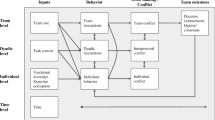Abstract
In this paper we investigate intergroup conflict and examine the impact of strategies to manage and hopefully reduce it. To do this, we use a probabilistic computer simulation model, based on feedback principles. The model examines how conflict between two groups evolves over time. Group differences and the occurrence of intergroup incidents drive the model. Intergroup hostility which depends on past history, recent conflict incidents, and group differences is the key variable that indicates the proclivity toward conflict between the two groups. We use the model to examine various cases and the effect of conflict management strategies. Based on the model results, we develop some conclusions about the applicability of the findings to actual situations, as well as directions for further research.
Similar content being viewed by others
References
Axelrod, R.: 1980, 'Effective Choice in the Prisoner's Dilemma', Journal of Conflict Resolution 24, 3–25.
Bendor, J.: 1993, 'Uncertainty and the Evolution of Cooperation', Journal of Conflict Resolution 37(4), 709–734.
Carlson, L.: 1995, 'A Theory of Escalation and International Conflict', Journal of Conflict Resolution 39(3), 511–534.
Carment, D.: 1995, 'Internal Constraints and Interstate Ethnic Conflict', Journal of Conflict Resolution 39(1), 82–109.
Castelfranchi, C., R. Conte, and M. Paolucci: 1998, 'Normative Reputation and the Costs of Compliance', Journal of Artificial Societies and Social Simulation 1(3), http://www.soc.surrey.ac.uk/ JASSS/1/3/3.html.
Dion, D.: 1997, 'Competition and Ethnic Conflict', Journal of Conflict Resolution 41(5), 638–648.
Jager, W., R. Popping and H. van de Sande: 2001, 'Clustering and Fighting in Two-Party Crowds: Simulating the Approach-Avoidance Conflict', Journal of Artificial Societies and Social Simulation 4(3), http://www.soc.surrey.ac.uk/JASSS/4/3/7.html.
Karmeshu, B., V. P. Jain and K. Mahajan: 1990, 'A Dynamic Model of Domestic Political Conflict Process', Journal of Conflict Resolution 34(2), 252–270.
Miller, H. and K. Engemann: 1999, 'Determinant Factors for Modeling Conflict Systems', in G. Lasker (ed.), Advances in Sociocybernetics and Human Development, Volume VII: Conflict Resolution, Collaborative Consciousness, Sustainable Devolopment and Education, pp. 115-119, IIAS 1999.
Munvaster, R. G. and D. A. Zinnes: 1982, 'A Model of International Hostility Dynamics and War', Conflict Management and Peace Science 6(2), 19–37.
O'Riordan, Colm: 2000, 'A Forgiving Strategy for the Iterated Prisoner's Dilemma', Journal of Artificial Societies and Social Simulation 3(4), http://www.soc.surrey.ac.uk/JASSS/3/4/3.html.
Patrick, S., P. Dorman, M. Patricia and R. I. Marsh: 1999, 'Simulating Correctional Disturbances: The Application of Organization Control Theory to Correctional Organizations via Computer Simulation', Journal of Artificial Societies and Social Simulation 2(1), http://www.soc.surrey.ac.uk/ JASSS/2/1/l.html.
Read, D. W.: 1998, 'Kinship Based Demographic Simulation of Societal Processes', Journal of Artificial Societies and Social Simulation 1(1), http:// www.soc.surrey.ac.uk/JASSS/1/1/1.html.
Schock, K.: 1996, 'A Conjunctural Model of Political Conflict', Journal of Conflict Resolution 40(1), 98–133.
Suleiman, R. and I. Fischer: 2000, 'When One Decides for Many: The Effect of Delegation Methods on Cooperation in Simulated Intergroup Conflicts', Journal of Artificial Societies and Social Simulation 3(4), http://www.soc.surrey.ac.uk/ JASSS/3/4/1.html.
Thebaud, O. and Locatelli, B.: 2001, 'Modelling the Emergence of Resource-Sharing Conventions: An Agent-Based Approach', Journal of Artificial Societies and Social Simulation 4(2), http:// www.soc.surrey.ac.uk/JASSS/4/2/3.html.
Wolfson, M.: 1973, 'A Dynamic Model of Present World Conflict', Papers of the Peace Science Society 20, 43–64.
Wolfson, M., A. Puri and M. Martelli: 1992, 'The Nonlinear Dynamics of International Conflict', Journal of Conflict Resolution 36(1), 119–149.
Zeggelink, E. P. H., H. de Vos, D. Elsas: 2000, 'Reciprocal Altruism and Group Formation: The Degree of Segmentation of Reciprocal Altruists who Prefer “oldhelping-partners”', Journal of Artificial Societies and Social Simulation 3(3), http://www.soc.surrey.ac.uk/JASSS/3/3/1.htm.
Author information
Authors and Affiliations
Rights and permissions
About this article
Cite this article
Miller, H., Engemann, K.J. A Simulation Model of Intergroup Conflict. Journal of Business Ethics 50, 355–367 (2004). https://doi.org/10.1023/B:BUSI.0000025030.60387.c3
Issue Date:
DOI: https://doi.org/10.1023/B:BUSI.0000025030.60387.c3




